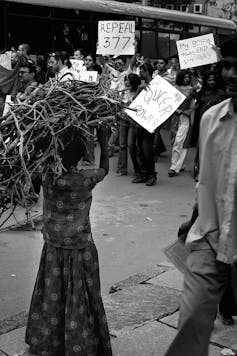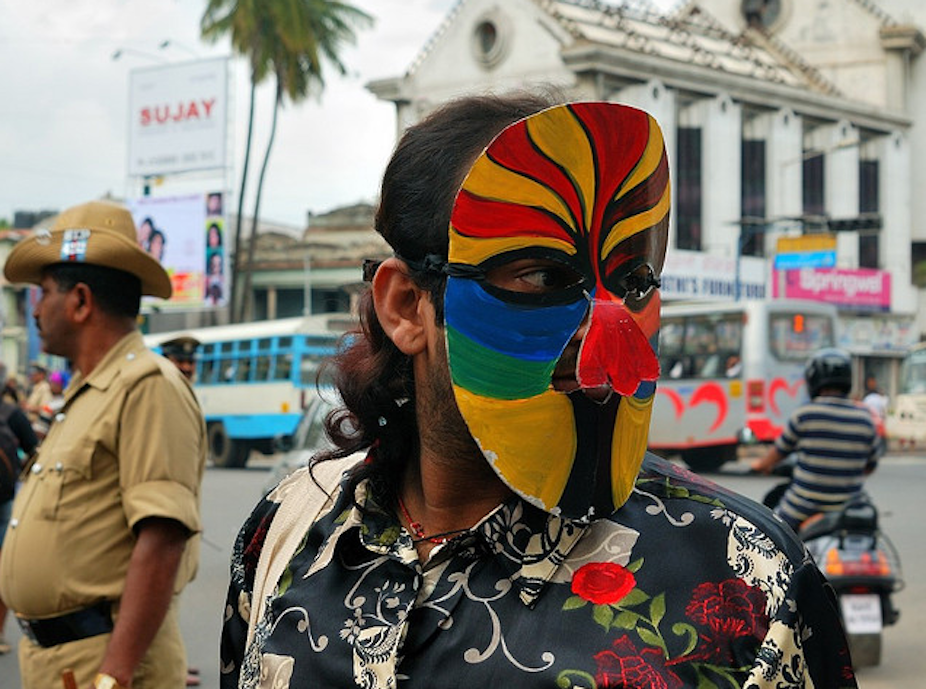Prompting international outrage, the Supreme Court of India has overturned a “reading-down” of the notorious Section 377 of the India Penal Code.
This, in effect, reinstated a law that is widely understood to criminalise homosexuality. Many see this as a betrayal of basic human rights, particularly freedom of sexual expression and protection from harassment and abuse on grounds of sexual difference.
For lots of activists, the decision has significant symbolic implications in terms of India’s image in the international arena. India had previously looked relatively progressive on the world stage in terms of minority sexual rights. This was part of a package of other attributes, such as growing socio-economic liberalism and urbanising modernity in the sub-continent, often associated with sexual progress despite their problematic impacts in terms of poverty and the wealth gap. Now, a more regressive image suddenly seems to have taken centre stage.

The Supreme Court decision is especially important not only because it stirs up a new set of concerns for same-sex desiring and practising people in India, but because it appears to upset an equivalence between legislative progress on sexual rights and the image of India as a modern, secular and progressive nation. This speaks to another set of anxieties too – the possibility that next year’s elections could result in a right-wing victory, bringing a fresh wave of religious conservatism and a divided vision for what a future India might look like.
But in marked contrast to the symbolic and emotional importance the decision has acquired, many activists and scholars (including representatives of working-class LGBT communities in India) feel that the judgement and Section 377 itself is being given far more importance than it deserves, and is being misrepresented as “criminalising” homosexuality.
The law’s an ass
Activists and scholars like Nithin Manayath and Kaveri R Indira have pointed out that the relationship between the law and its purported effects is not backed up by much evidence. While the campaign against the law made Section 377 into a symbol for the criminalisation of homosexuality and sought to provide legal sanction to gay/lesbian sex in private, the law seems to have been very rarely used to target consensual sex in private.
The text of the law makes no separate reference to LGBT people, only to sex against “the order of nature” – and this clause has largely not been used to target private sex among LGBT people. Rather, the law has been evoked in some cases of police violence and abuse against working-class transgender and other LGBT people in public spaces – and even then, only rarely. Indeed, three out of the five cases of violence cited in the positive 2009 verdict of the Delhi High Court, which removed consensual sex in private from the purview of IPC 377, did not involve IPC 377 directly. Where they did, 377 was not the only, or even the chief, law under which people were charged. Moreover, as the 2013 Supreme Court judgement notes, 377 has been more commonly used to target non-consensual anal or oral sex. This means that the police themselves may be technically liable under the law in cases where they rape or sexually abuse LGBT people, or indeed use sexual violence against women and men more generally.
Raina Roy, a Kolkata-based transgender activist, and Indira, who is based in Hyderabad, have pointed out that the police rarely need to use legal excuses to harass, abuse or rape socio-economically marginalised transgender and gay people. And when they do, they often evoke other laws concerning public order, decency, sex work or obscenity. So, the link between IPC 377 and gay/lesbian criminalisation or liberation is more symbolic than material. The victory was a symbolic victory, and this is a symbolic defeat.
This is not to say that the symbolic victory achieved via the original reading-down of IPC 377 in 2009 was not significant. The case against IPC 377, which was originally brought by the Naz Foundation at the Delhi High court, originated from the idea of a sexual subject who was vulnerable both before the law and in terms of health (HIV-AIDS).
In particular, “men who have sex with men” and transgender people were advocated as people in need of protection from violence and sexual risk (vulnerable via male-to-male penetration, or via assault), rather than as threats to masculinity or wider cultural values. That original framing may have been superseded, but in some ways it has persisted; it perhaps helps to see the current Supreme Court judgement in this context.
The original reading-down of IPC 377 was thus based on a very specific set of concerns. Advocating for the right to privacy looked like a viable strategy, based as much on promoting safer sexual lives as on claiming rights and recognition. But in the longer run, the privacy argument actually hampered the efficacy of the campaign and the positive 2009 judgement for countering violence against socio-economically marginal LGBT sections (who more typically have lacked private spaces for sexual practice) - the very people whose stories were evoked to bolster the campaign against IPC 377.
Dangerous new ground
Against this background, the new Supreme Court judgement reintroduces vulnerability in a new way. The extensive visibility acquired by the judgement means that IPC 377 might be acquiring more dangerous connotations than it ever did before; over the years, many more people – including the police – have come to know that it might be used as a a stick with which to beat LGBT people.
But the blame for that exaggerated importance may perhaps rest more with the media reaction, extensive liberal outrage, and attendant misrepresentations of the law, than with the judgement itself. The current outrage provoked by the new Supreme Court judgement is a direct result of the symbolic importance invested in the original 2009 decision.
This is not to divest the present judgement of significance, in terms of its implications for sexual and gender minority rights. Ironically, however, the judgement may also mark a realisation that vulnerability in the lives of transgender or sexually marginalised people goes way beyond Section 377 – and that we need to bring these wider concerns to the centre-ground of contemporary and future Indian politics.

